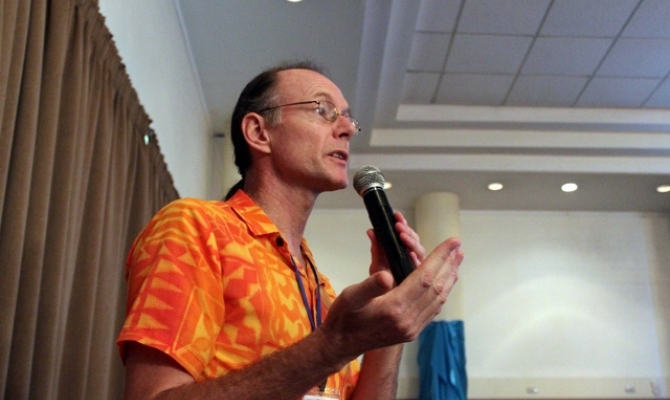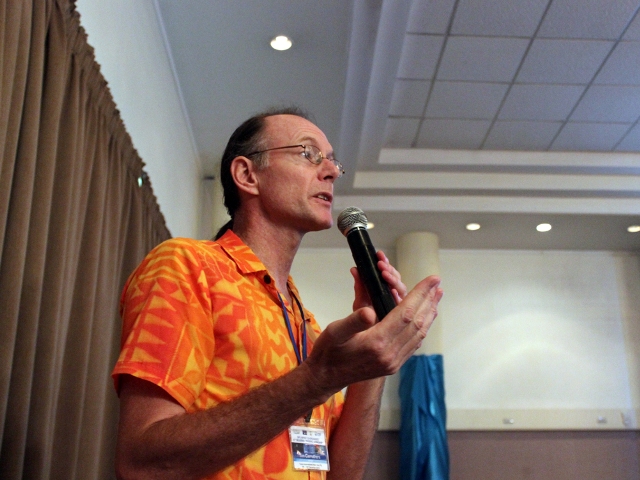
Biodiversity Conservation
By Steve Pogonowski, 12 December 2013, Suva Fiji - The proposed establishment of a regional supervisory body for deep sea mining in the Pacific region and emphasis on the value of marine spatial planning formed part of discussions at the 4th Regional Training Workshop: Environmental Perspectives of Deep Sea Mineral Activities in Nadi, Fiji.
Working groups began planning strategies on building regional cooperation, increasing awareness of marine spatial planning and creating environmental impact assessment (EIA) templates for deep sea mineral mining.
The template documents coud be tailored by individual countries to determine the impact of planned mining activities in each area.
 Dr. Tim Carruthers Photo courtesy of SPC
Dr. Tim Carruthers Photo courtesy of SPC
SPREP marine and coastal adviser Dr. Tim Carruthers said strategic evaluations of an area's ecosystems combined with informed marine spatial planning would be a positive step towards handling potential mining projects.
He said Pacific Island countries and territories would need to "actively engage in the discussion as to what uses can be appropriate for each area."
One of the working groups suggested the establishment of a regional secretariat body to provide training for independent observers, monitor mining operations and provide other regulatory services to individual governments.
The group also identified the positive impact of cooperation between national governments where transboundary deep sea mining operations are occurring, which would make it easier for external companies to invest.
"A harmonised regime across the region will provide a secure and familiar regime for companies, while will make the Pacific EEZs a more attractive operating and investment environment," the group noted.
Manganese nodules were one of the deep sea minerals rich in rare earth elements being discussed during the workshop and one working group drafted a list of current gaps and challenges for Pacific nations in dealing with nodule mining.
Some of the identified gaps included:
- Impact assessment methods needs to be described in the EIA so it is clear how conclusions were reached and ensuring objectivity (e.g. why a particular impact was assigned high risk instead of low risk)
- Awareness that if proposal includes significant onshore components, then the EIA template would have to be appropriately expanded to encompass potential effects (e.g. water quality, light, noise)
- Assessing multiple scenarios so that assessments are flexible, covering the various potential production rates of mining operations.
The workshop will officially close tomorrow.
Working groups began planning strategies on building regional cooperation, increasing awareness of marine spatial planning and creating environmental impact assessment (EIA) templates for deep sea mineral mining.
The template documents coud be tailored by individual countries to determine the impact of planned mining activities in each area.
 Dr. Tim Carruthers Photo courtesy of SPC
Dr. Tim Carruthers Photo courtesy of SPCHe said Pacific Island countries and territories would need to "actively engage in the discussion as to what uses can be appropriate for each area."
One of the working groups suggested the establishment of a regional secretariat body to provide training for independent observers, monitor mining operations and provide other regulatory services to individual governments.
The group also identified the positive impact of cooperation between national governments where transboundary deep sea mining operations are occurring, which would make it easier for external companies to invest.
"A harmonised regime across the region will provide a secure and familiar regime for companies, while will make the Pacific EEZs a more attractive operating and investment environment," the group noted.
Manganese nodules were one of the deep sea minerals rich in rare earth elements being discussed during the workshop and one working group drafted a list of current gaps and challenges for Pacific nations in dealing with nodule mining.
Some of the identified gaps included:
- Impact assessment methods needs to be described in the EIA so it is clear how conclusions were reached and ensuring objectivity (e.g. why a particular impact was assigned high risk instead of low risk)
- Awareness that if proposal includes significant onshore components, then the EIA template would have to be appropriately expanded to encompass potential effects (e.g. water quality, light, noise)
- Assessing multiple scenarios so that assessments are flexible, covering the various potential production rates of mining operations.
The workshop will officially close tomorrow.